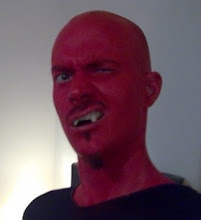Alien vs. Predator 2: Requiem
AvP2 is the film that the first instalment in the franchise mash should have been realistically, if not ideally - flawed and predictable and ignorant in the possibilities of theme and character development found in some of the comics, but trashy fun nonetheless. Essentially, Predators crash-land and die on present day Earth, Aliens escape into a small, isolated town in the USA, more Predators come to clean up the mess.
The first film, Paul W.S. Anderson’s Arctic pyramid-set travesty, felt similar to his previous Resident Evil adaptation . There’s a tangible quality absent, an unerring feel of
inauthenticity or plasticity, as if the whole thing is held together with
CGI effects too shiny and uniform to give the production any weight.
AVP2 at least feels more ‘real’ with its effects work and it features so many franchise and general horror film
clichés that it feels familiar and so grounded. From the conventions of small-town America - the local sheriff, diner waitress and local
badboy/rich family’s daughter tension - to a Predator’s ungainly fingers flitting over its wrist console and the distressed elephant squeal of a dying Alien, the film crams in as many reference points as possible to keep the
fanboys on board.
We have
facehuggers (though the gestation period seems to be much shorter in the present day centuries before the first films were set), Alien secondary-jaw head chomping, a Predator swanning about being a bad ass warrior until finally taking off its mask near the end for a good mandible-roar and bit of fisticuffs, the Predator console-bomb going off, a brief swimming Alien shot referencing Alien: Resurrection, a National Guard commander hearing his whole squad being swiftly taken out from his command centre, shots of Aliens slowly moving their faces up against the heads of very distressed people, ignoring the fact that the background to this shot ripped from Alien3 is that Ripley was impregnated with a queen and so spared the usual quick dispatch.
This last example sums up the general tone of the film, intent on recycling any “Woah, cool!” moments whilst seemingly oblivious to the qualities that made these franchises memorable besides the effects work.
New inventions include the Predator’s pleasantly luminous disintegration liquid - a small measure and any pesky bodies that would be evidence of the accidental introduction of Aliens to the planet are swiftly dissolved. One other invention is another example of the affectionate yet blinkered view of the creators. Alien3 put forward the idea that an Alien would incorporate some of the characteristics of the host species, meaning that whilst similar to the Aliens of human origin from previous films, the dog Alien from the third movie was inclined to move on all fours with a slightly elongated trunk. AVP2 has taken this idea and come up with the
Predalien, a result of a Predator being the host species. Rather than a variation on the original
Giger Alien design this one is not only significantly larger (despite little variation regardless of the age/gender/size of a human host) but sports the mandibles and rubbery dreadlocks of the Predator. Yes, dreadlocks.
The unknown cast help to create a level of tension as you are kept guessing about who’s next on the menu - if a baby ward at a hospital is at risk then everything’s up for grabs, but on the other hand the lack of any real character development makes it hard to care who’s next.
Whilst certainly better than the first film this is faint praise indeed, and it’s a shame that more hasn’t been made of it considering the wealth of ideas that have been generated around these two
xenomorphs in the last two or three decades.
A very, very average action/horror B-pic, remarkable only due to its
nasties.

